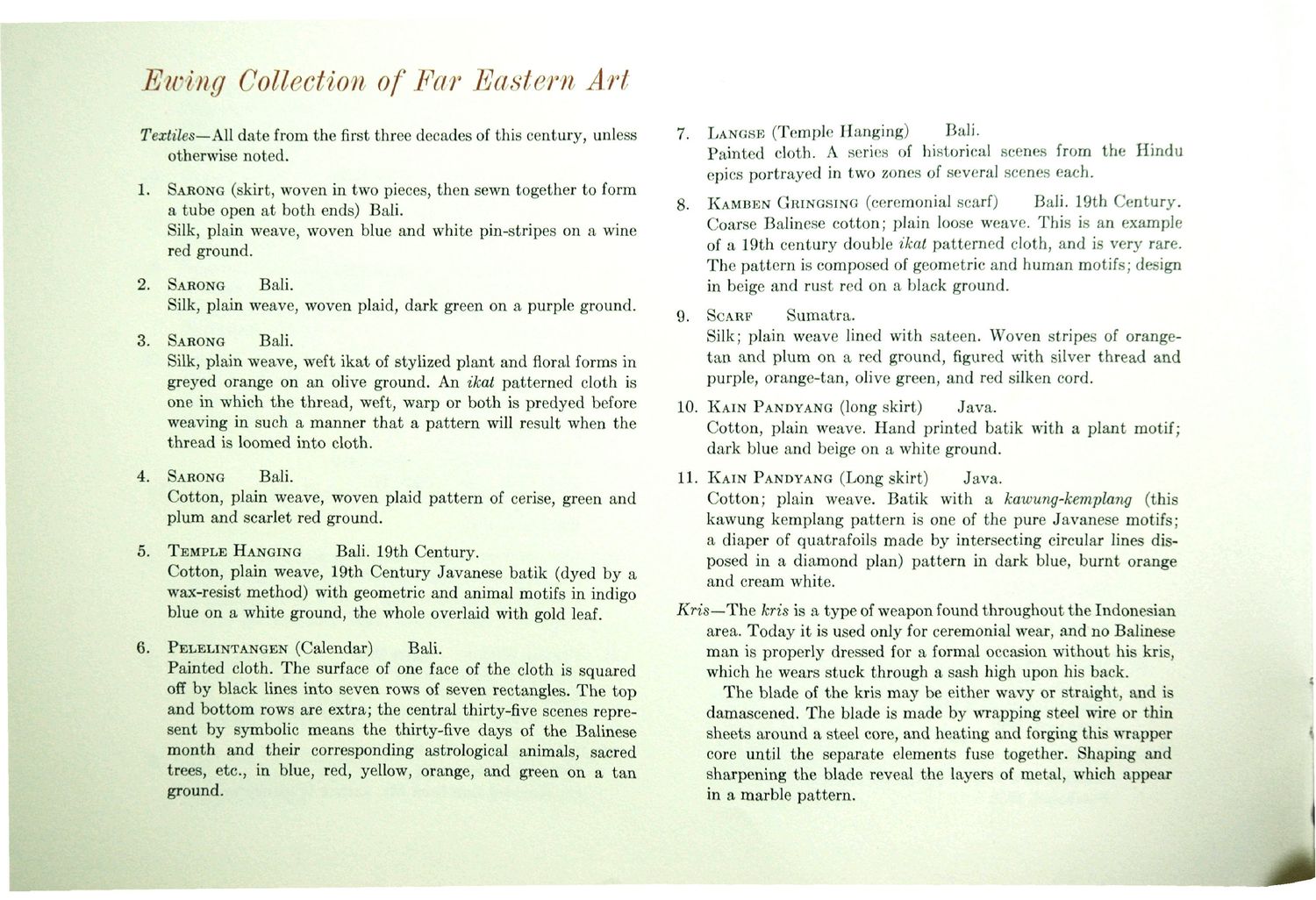| |
| |
Caption: Dedication - Krannert Art Museum
This is a reduced-resolution page image for fast online browsing.

EXTRACTED TEXT FROM PAGE:
Ewing Collection of Far Eastern Art Textiles—All date from the first three decades of this century, unless otherwise noted. 1. SAKONG (skirt, woven in two pieces, then sewn together to form a tube open at both ends) Bali. Silk, plain weave, woven blue and white pin-stripes on a wine red ground. 2. SARONG Bali. Silk, plain weave, woven plaid, dark green on a purple ground. 3. SARONG Bali. Silk, plain weave, weft ikat of stylized plant and floral forms in greyed orange on an olive ground. An ikat patterned cloth is one in which the thread, weft, warp or both is predyed before weaving in such a manner that a pattern will result when the thread is loomed into cloth. 4. SAKONG Bali. Cotton, plain weave, woven plaid pattern of cerise, green and plum and scarlet red ground. 5. TEMPLE HANGING Bali. 19th Century. Cotton, plain weave, 19th Century Javanese batik (dyed by a wax-resist method) with geometric and animal motifs in indigo blue on a white ground, the whole overlaid with gold leaf. 6. PELELINTANGEN (Calendar) Bali. Painted cloth. The surface of one face of the cloth is squared off by black lines into seven rows of seven rectangles. The top and bottom rows are extra; the central thirty-five scenes represent by symbolic means the thirty-five days of the Balinese month and their corresponding astrological animals, sacred trees, etc., in blue, red, yellow, orange, and green on a tan ground. 7. LANGSB (Temple Hanging) Bali. Painted cloth. A series of historical scenes from the Hindu epics portrayed in two zones of several scenes each. 8. KAMBEN GRINGSING (ceremonial scarf) Bali. 19th Century. Coarse Balinese cotton; plain loose weave. This is an example of a 19th century double ikat patterned cloth, and is very rare. The pattern is composed of geometric and human motifs; design in beige and rust red on a black ground. 9. SCARF Sumatra. Silk; plain weave lined with sateen. Woven stripes of orangetan and plum on a red ground, figured with silver thread and purple, orange-tan, olive green, and red silken cord. 10. KAIN PANDYANG (long skirt) Java. Cotton, plain weave. Hand printed batik with a plant motif; dark blue and beige on a white ground. 11. KAIN PANDYANG (Long skirt) Java. Cotton; plain weave. Batik with a katoung-kemplang (this kawung kemplang pattern is one of the pure Javanese motifs; a diaper of quatrafoils made by intersecting circular lines disposed in a diamond plan) pattern in dark blue, burnt orange and cream white. Kris—The kris is a type of weapon found throughout the Indonesian area. Today it is used only for ceremonial wear, and no Balinese man is properly dressed for a formal occasion without his kris, which he wears stuck through a sash high upon his back. The blade of the kris may be either wavy or straight, and is damascened. The blade is made by wrapping steel wire or thin sheets around a steel core, and heating and forging this wrapper core until the separate elements fuse together. Shaping and sharpening the blade reveal the layers of metal, which appear in a marble pattern.
| |